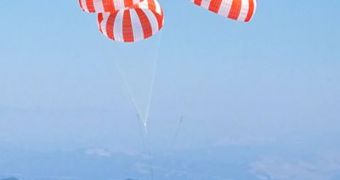This month, SpaceX completed successfully its first Dragon high altitude drop test with the purpose of validating the parachute deployment system and recovery operations before the first flight of an operational Dragon, later this year.
On the August 12, nine miles off the coast of Morro Bay, California, an Erickson S-64F Air-Crane helicopter dropped a test article of the Dragon spacecraft from 14,000 feet above the water.
Thanks to its precise sequence of events, dual redundant drogue parachutes deployed and stabilized the spacecraft before slowing it down.
Once the drogues were completely deployed, the main parachute was released, deploying after the drogues detached from the spacecraft.
Even though Dragon will carry cargo, it was built for carrying crew, so the parachute system validated during the drop test is the same that will be used on a crew-carrying spacecraft.
The three main parachutes were made by Airborne Systems and they are so solid that even if one would be lost, the other two would still make a soft landing for the crew.
The test article landed perfectly within the landing zone, but the actual landing of an operational Dragon will be even more precise, Space Fellowship reports.
This is due to the Draco thrusters fired during reentry, that control the landing location and make sure the spacecraft lands less than a mile away from the desired landing place.
For the first crewed flights, Dragon will be lifted to shore by helicopter, but the company's long term goal is to have it land on land.
SpaceX succeeded this flight thanks to the Dynegy Morro Bay Power Plant, Erickson Air-Crane, Angel City Air Aerial Photography, Associated Pacific Constructors of Morro Bay, Castagnola Tug Service, Morro Bay Harbor, Fire and Police Departments, US Coast Guard Morro Bay Station, The Federal Aviation Administration, Morro Bay Planning Division, Protech Express Towing, SloDivers, Centurion Private Security, Coast Diving Service and Woody Wordsworth at Radio Shack Morro Bay.

 14 DAY TRIAL //
14 DAY TRIAL //